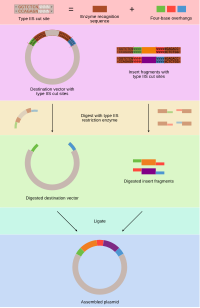
Photo from wikipedia
In vivo localization of proteins using fluorescence-based approaches by fusion of the protein of interest (POI) to a fluorescent protein is a cost- and time-effective tool to gain insights into… Click to show full abstract
In vivo localization of proteins using fluorescence-based approaches by fusion of the protein of interest (POI) to a fluorescent protein is a cost- and time-effective tool to gain insights into its physiological function in a plant cell. Determining the proper localization, however, requires the co-expression of defined organelle markers (OM). Several marker sets are available but, so far, the procedure requires successful co-transformation of POI and OM into the same cell and/or several cloning steps. We developed a set of vectors containing markers for basic cell organelles that enables the insertion of the gene of interest (GOI) by a single cloning step using the Golden Gate cloning approach and resulting in POI–GFP fusions. The set includes markers for plasma membrane, tonoplast, nucleus, endoplasmic reticulum, Golgi apparatus, peroxisomes, plastids, and mitochondria, all labelled with mCherry. Most of them were derived from well-established marker sets, but those localized in plasma membrane and tonoplast were improved by using different proteins. The final vectors are usable for localization studies in isolated protoplasts and for transient transformation of leaves of Nicotiana benthamiana. Their functionality is demonstrated using two enzymes involved in biosynthesis of jasmonic acid and located in either plastids or peroxisomes.
Journal Title: Plants
Year Published: 2022
Link to full text (if available)
Share on Social Media: Sign Up to like & get
recommendations!